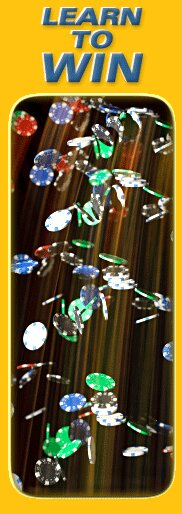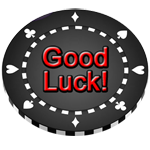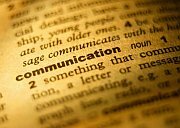Basic Blackjack Strategy is the Way to Play
by Frank Scoblete
Blackjack is one of the best table games and basic blackjack strategy is the way to play, as you will learn in this lesson. Along with poker, gaming writers extol the virtues of this casino game. Many novice players believe blackjack is a great game as well. As soon as they head into the casino, they storm the blackjack tables and often discover that blackjack is deadly! They lose their shirts.
You see, blackjack is only a good game if you use the right strategy, boringly called basic blackjack strategy; otherwise, players can face edges of from 2 to 6 percent or more, depending on how they play their hands.
Blackjack can be a very fast game, where the casino can get in anywhere from 60 to 100 decisions per hour. Bad strategy plus fast game equals disaster for the players.
One of the big blunders first-time blackjack players make is to figure that if the house has their dealers play a certain way, and the house has an edge, then that must be the best way to play for the players as well. In fact, it is one of the worst!
The house rules generally have the dealer standing on 17.
However, some casinos have dealers hit their soft 17s=Aces + 6 for example, that is a bad option for the players hitting on any hand that is 16 or less until they get to 17 or more.
Dealers do not double down, split pairs or surrender, if that option is offered. Therefore, players who 'mimic the dealer' will face a house edge close to six percent.
Example: If you are a ten-dollar player playing 80 hands per hour, that means you can expect to lose about $48 per hour in the long run if you persist in playing like the dealer. Four hours of play will see you digging into your kid's college fund to the tune of $192.
That's hardly using basic blackjack strategy.
Why is this 'mimic the dealer' style so awful? Because the dealer plays his hand last. If a player goes over 21 and busts followed by the dealer busting, the result is not a tie, but a player loss! That is the big edge for the casino where the dealer can bust yet still beat the player.
Some players play even worse strategies than 'mimic the dealer'.
You see them making all the wrong moves, hitting their 17s, splitting fives and tens, doubling on 12s, standing on 16 against a dealer’s seven, and standing on their eights and nines.
However, wise players who learn basic blackjack strategy will discover that the game does indeed deserve the plaudits it has received from the gambling experts. If you play correct strategy which is the computer-derived play of every player hand against every dealer upcard, you will find yourself facing an approximately one-half percent casino edge and sometimes, even less.
Such a player playing ten dollars per hand for 80 hands per hour would expect to lose only four dollars per hour in the long run. That is very different from the $48 dollars per hour of the 'mimic the dealer' strategy.
Basic blackjack strategy tends to be logical, intuitive, and often obvious.
- If you have a blackjack that is a 21 with two cards, you would not treat it as an eleven and double down and you would happily take your three-to-two payout.
- If you have a 20, you would stand against all dealer upcards. The same strategy follows with a 17, 18 or 19.
- Any time the dealer is strong and you are weak, you would hit your hands of 12, 13, 14, 15 or 16. That means hit these hands when the dealer has a 7, 8, 9, 10, face card, or Ace showing.
- When the dealer is weak and you are weak, you let the dealer take a hit. That means standing on your 13, 14, 15, or 16 when the dealer shows a 2, 3, 4, 5, or 6.
In fact, they feel wrong. For example, you always hit your 12 against a dealer’s upcard of 2 or 3. Many players will steer clear of doing this but the computers have shown, in analyzing billions of 12s against dealer upcards of 2 and 3, that you lose less money when you hit than when you stand.
Another counter-intuitive move is the splitting of 8s against a dealer upcard of 10 or Ace. Very few players enjoy the prospect of taking their 16, a losing hand, splitting the 8s and facing a powerful dealer upcard with the resulting two hands and double the money on the table. Still, it is the right thing to do. A 16 is a loser against a 10, any way you slice it. But a split pair of 8s will lose you less money in the long run even though you are putting up twice the money! Strange but true. In this case, you don’t follow your fears; you split the 8s and trust the math.
There are other counter-intuitive moves to basic blackjack strategy. No one likes to hit Ace+7=soft 18 against a dealer’s 9, 10 or Ace. But in the long run, 18 is a losing hand for a player.
The average winning hand for a player is approximately 18.8. So even though it feels wrong to hit your soft 18s against a dealer 9, 10 or ace, you must do it.
Pair splitting strategies can also cause one to pause. Who wants to split a pair of 2s or 3s against a dealer’s 2 in games where you can double after splits? Very few. The fear is that you will get a ten on each, hit each, get more tens and bust. The fact is you will win more money if you split those low cards in such a situation.
Once you have mastered this strategy, you can head for the tables and play a really tight game against the casinos. In fact, with comps thrown in, strategy players lose very little money and some even have a monetary edge over the casino. A monetary edge just means that between what you lose in the game, that half percent, and what you get in dollar value for comps, you are taking more in then you are giving out.
For blackjack players, the rule is clear. Play basic blackjack strategy or don’t play at all.
Basic blackjack strategy is followed by strategy cards
OR
Return to Learn to Play Blackjack Program
Gambling Teachers Home
GT is attentive about getting the word out about our free programs, lessons and add-ons offered, however, we ask your assistance and consideration in promoting us.
Click link below that reads, "Enjoy this page? Please pay it forward. Here's how..." to add a link to your site, blog or personal page.
Tips, Terms & Wins
Blackjack Side Bet: Pair Square
A player wins this side bet if his first two cards are of the same rank. For a 6-deck game, the payoff for an unmatched pair is 10 to 1 and if matched the payoff increases to 15 to 1.
The payoffs vary for different number of decks of cards but the casino’s edge in all cases is around 6% or more. Bet to Avoid.





